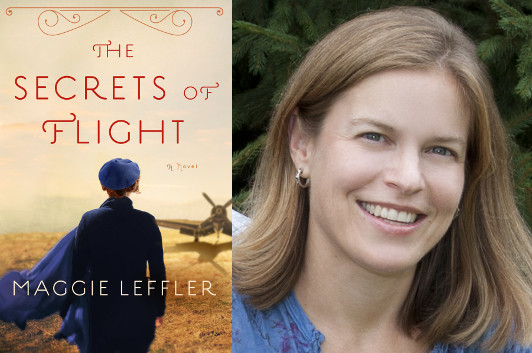Maggie Leffler’s Long Path to Flight

photo: Hills Studio
I first got to know Maggie Leffler just over nine years ago, when her debut novel, The Diagnosis of Love, came out. Now I’m reading her third book, The Secrets of Flight, and I’m hooked by its interlocking stories about two young women trying to figure out who they want to be… and how to become it—but also, as you’ll see, what happens years later, after the choices you’ve made and the circumstances you can’t control. Now, one of the reasons it’s been so long since a follow-up to Leffler’s first two books is that she has a full-on career as a family physician, but as you’ll learn in this guest essay, it also took her longer than she’d anticipated to find the right shape for this particular narrative. She did, though, and that’s great news for us.
Madeleine L’Engle once wrote, “I think that all artists, regardless of degree of talent, are a painful, paradoxical combination of certainty and uncertainty, of arrogance and humility… and yet with a stubborn streak of faith in their own validity no matter what.” Over the last six years of writing my third novel, these words have never felt truer.
In 2009, after reading about President Obama honoring World War II’s forgotten “fly girls” with Congressional Gold medals, I set out to write a family saga from four points of view, including that of a Women Airforce Service pilot (WASP). After it was completed in 2012, my agent sent The Secrets of Flight out to a round of rejections. The manuscript was overstuffed with characters, and, to boot, one of them, Jane, was unlikable (poor Jane!). Two drafts later, after the novel went out again—sans Jane—to be met with more rejections, I was in despair, yet compelled to keep writing all the same. Sometimes it’s not conviction urging me onward, but the story itself that needs to come out before I’m consumed.
That same summer, I confessed to my husband a secret dream of mine since the age of fourteen: I wanted to make a film, but I was scared to learn how. What if my attempts were awful? He pushed me to take a class at Pittsburgh Filmmakers, which gave me a different perspective for the book—or at least a healthy break from it. With each passing year, it became easier to kill another darling.
Soon the novel belonged to the two main characters I’d conjured up in the very beginning: Mary, the former WWII pilot with a secret, and Elyse, the big-hearted teen who would save her. Another distinct point of view also emerged, that of the young pilot’s… except that I had no idea what it felt like to have flown planes during the war. Finding the answers led to a friendship with Florence Shutsy-Reynolds, a Women Airforce Service pilot who inspired me with her stories. Finally, in 2014, the novel was ready for another round.
That fall, I distracted myself from waiting for news by making plans to film the book trailer. My writers group critiqued drafts of the script, and I started lining up the cast. Since a third of the book now took place during World War II, I would need costumes and props, a daunting task. Hearing my plans, a friend gently reminded me that I was picking songs for a book trailer on a manuscript that wasn’t being published. This was the depressing truth: after round three, the book still hadn’t sold.
I began another draft, this time focusing on the wartime love story at the heart of the novel. And without any reasonable excuse to be doing so, I kept preparing for the trailer, cold-calling a complete stranger about using his antique car, shopping at an estate sale for 1940s dresses, and bidding on WASP silver wings on eBay.
In 2015, I finished The Secrets of Flight again and this time—to my complete joy—Amanda Bergeron at HarperCollins acquired the manuscript. That summer, with the goodwill of friends, family and strangers, we made the book trailer. Less than two minutes long, the little movie represents almost six years of dreaming.
I like to imagine how my children will remember the summer we shot the book trailer, the same way I like to think of how they will look back on their childhood, when writers came to the house on school nights and they got to stay up late listening to manuscript critiques and raiding the snacks. I hope they remember driving around the city with me, scouting locations. Or maybe they’ll recall the woman at the library, who saw my seven-year-old hitting the lights for a take, and my ten-year-old holding the boom mike, and how she’d asked, in all seriousness, what production company we were. If nothing else, I hope they’ll be inspired to learn new things at the risk of failing miserably and to approach life with the steadfast mindset of a writer—gambling on high hopes despite rejection, and listening to the ideas inside themselves waiting to take shape in the world.
Two notes: (1) Here’s the book trailer. (2) The character Leffler talks about taking out, Jane? She’s Elyse’s mother, and so she’s made her way back into the final version of the story, as seen through her daughter’s eyes—as to whether she’s “unlikable,” that’s up to you to decide; for me, it’s clear that Elyse is frustrated by her, but it’s also clear that she’s dealing with a lot of emotional turmoil coming at her all at once the only way she knows how.
8 May 2016 | guest authors |

 Our Endless and Proper Work is my new book with Belt Publishing about starting (and sticking to) a productive writing practice.
Our Endless and Proper Work is my new book with Belt Publishing about starting (and sticking to) a productive writing practice. 
